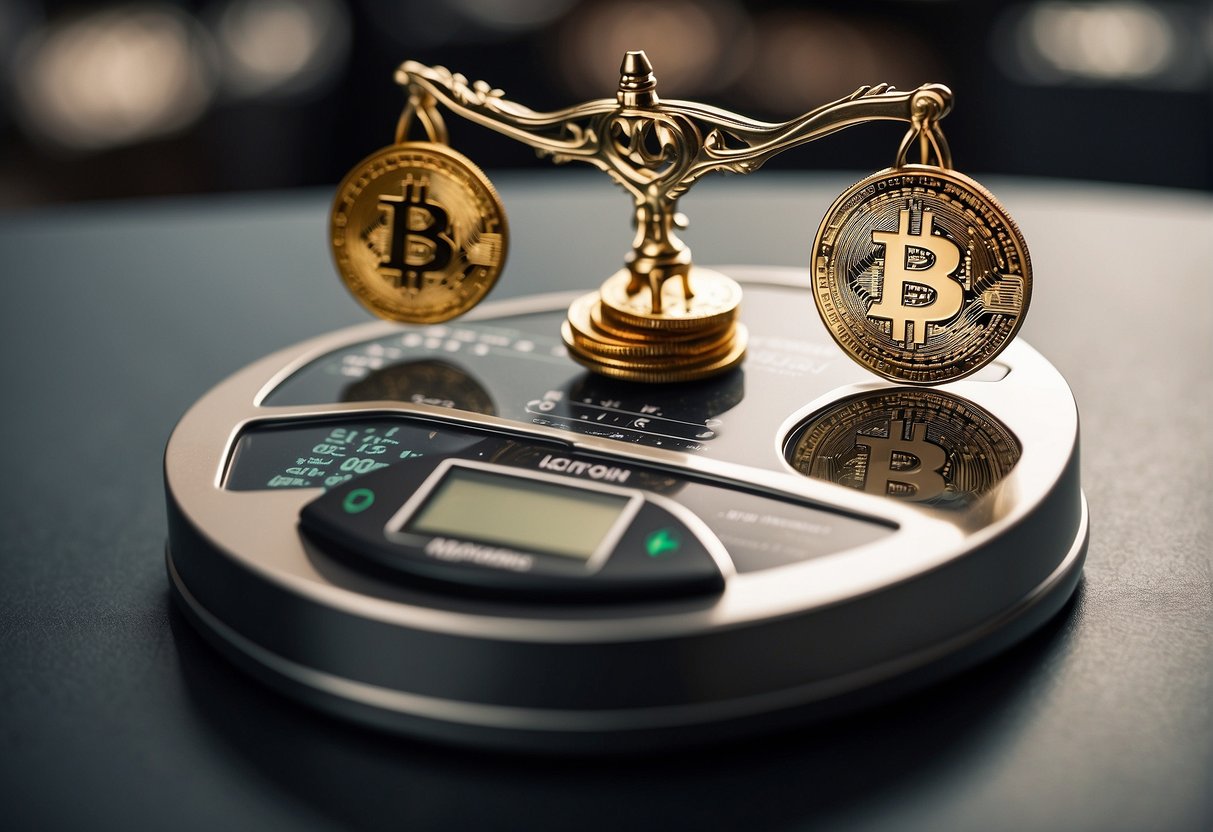The world of cryptocurrency has grown significantly since the introduction of Bitcoin in 2009. As the first and foremost cryptocurrency, Bitcoin has gained considerable attention, making it an attractive investment option for many. However, the cryptocurrency market is vast, and numerous alternative cryptocurrencies, or altcoins, have emerged over the years, offering potential investors a wide range of investment choices with varying levels of risk and possible return.

Investing in Bitcoin and altcoins presents unique challenges and opportunities for potential investors. It is essential to understand the critical differences between these two categories of cryptocurrencies when constructing an investment strategy. While Bitcoin is widely recognized as a store of value, it may not always offer the most significant potential for gains. On the other hand, despite their often lower market capitalization, investing in altcoins can provide unique technological innovation and utility features that create additional investment opportunities.
Key Takeaways
- Bitcoin remains the dominant cryptocurrency, but altcoins offer a range of investment opportunities with varying levels of risk and reward.
- Investors should consider market capitalization, technology, and utility features when allocating their cryptocurrency investments.
- A well-rounded investment strategy should encompass both Bitcoin and selected altcoins to capitalize on the unique opportunities presented by each.
Understanding Cryptocurrency
Cryptocurrency Fundamentals
Cryptocurrency is a digital or virtual currency that facilitates secure and decentralized transactions. It is often classified into two main categories: Bitcoin and altcoins. Bitcoin is the first and most well-known cryptocurrency, created in 2009. Altcoins, however, are any other cryptocurrencies launched after Bitcoin. They often offer functions or capabilities different from Bitcoin, considered a store of value [1].
Cryptocurrencies are built on blockchain technology, a decentralized digital ledger that records all transactions using the currency. This technology ensures that the data is transparent and secure, as it is distributed across numerous computers, called nodes. Some popular altcoins include Ethereum, Litecoin, and Ripple, each with unique features and utilities.
Blockchain Technology
In a blockchain, data is stored in blocks linked together chronologically. Each block contains transaction records, creating a continuous chain of blocks. Blockchain’s decentralized nature means that instead of a central authority managing the transactions, a network of nodes collectively validates each transaction via sophisticated algorithms [2].
Blockchain Key Features:
- Decentralization
- Security
- Transparency
- Immutability
Upon successful validation, new transactions are added to the blockchain, and the participating nodes update their copies of the shared ledger. Decentralization not only adds to the system’s security but also fosters trust among users while reducing the risk of manipulation by a single entity. This technology has given rise to digital assets and tokens, representing various utilities and functions within their underlying platforms.
In conclusion, understanding cryptocurrency fundamentals, such as Bitcoin and altcoins, along with the underlying blockchain technology, provides a solid foundation for exploring investment options in cryptocurrencies’ dynamic and ever-evolving world. Each type should be carefully analyzed and considered before considering cryptocurrency investment.
Bitcoin Overview
Origins of Bitcoin
Bitcoin, created by a person or group using Satoshi Nakamoto’s pseudonym, was introduced in 2009 as the first decentralized digital currency. Its innovative design utilizes blockchain technology to enable peer-to-peer transactions without relying on a central authority.
Bitcoin’s Market Dominance
As the pioneer of the cryptocurrency space, Bitcoin has maintained a dominant position in the market. With a market capitalization surpassing 1 trillion dollars, it holds a significant share compared to altcoins. Bitcoin is considered a store of value similar to gold and is often seen as a hedge against inflation.
Transactions using Bitcoin, however, face limitations such as low processing speeds and high transaction fees. Meanwhile, altcoins have surfaced to address these issues but have not reached the same adoption, utility, or market capitalization level as Bitcoin. While altcoins offer different functions and capabilities, Bitcoin remains a strong option for new and experienced investors.
Altcoins Explained
Altcoins, short for “alternative coins,” refer to any cryptocurrency other than Bitcoin. While Bitcoin has been the pioneer and the most recognized cryptocurrency, thousands of altcoins have emerged since its creation. These offer unique features that differ from Bitcoin, such as faster transaction times, intelligent contracts, and energy-efficient mining algorithms. Some popular altcoins include Ethereum, Litecoin, and Ripple. This section aims to provide an overview of altcoins and their different types and market dynamics.
Types of Altcoins
Several types of altcoins have unique characteristics. They are typically distinguished based on their technological improvements or different use cases. Here are a few common types:
- Platform Tokens (e.g., Ethereum): These altcoins function on their blockchain platforms, enabling developers to build decentralized applications (dApps) and smart contracts. For example, Ethereum is known for its smart contracts and has become the foundation for numerous dApps.
- Transaction Tokens (e.g., Litecoin): These altcoins focus on improving transactions by offering faster processing times, lower fees, or greater anonymity. Litecoin, for instance, is famous for its shorter transaction times than Bitcoin.
- Utility Tokens (e.g., Ripple): Designed for specific applications, utility tokens grant users access to a product or service. Ripple, as an example, aims to facilitate international money transfers for banks and financial institutions.
Investors also often consider diversification when selecting which altcoins to invest in. A diversified portfolio could potentially reduce risk while still providing potential growth opportunities.
Altcoin Market Dynamics
Altcoins usually coexist with Bitcoin but are often influenced by its price fluctuations. Factors such as technological advancements, new project developments, and the overall market sentiment can drive the price movement of altcoins. However, it’s important to mention that altcoins are generally more volatile than Bitcoin, which could lead to higher rewards and risks.
Altcoins are typically traded on cryptocurrency exchanges, sometimes paired directly with other cryptocurrencies like Bitcoin or stablecoins like Tether. Investors should consider an altcoin’s market capitalization, trading volume, and project fundamentals when evaluating investment options.
In conclusion, altcoins offer various investment possibilities for individuals looking to diversify their cryptocurrency portfolios. While numerous altcoins cater to multiple use cases and feature unique technologies, understanding their characteristics and market dynamics is crucial for making informed investment decisions.
Investment Strategies
When it comes to investing in digital currencies, there are several strategies to consider. This section will discuss two popular approaches: long-term holding and short-term trading. These investment strategies can apply to Bitcoin and altcoins in your crypto portfolio.
Long-Term Holding
Long-term holding, also known as “Holding,” involves purchasing crypto assets to hold them for an extended period, often years. This approach is similar to traditional investments like stocks, where investors expect the value to increase over time.
Pros:
- Lower risk: Investors reduce their exposure to short-term market fluctuations by holding longer.
- Reduced stress: There is less need to monitor daily price movements, making it a more passive investment strategy.
- Potential for substantial growth: Long-term holders may enjoy significant investment returns if the selected cryptocurrencies perform well. For example, Bitcoin’s value has historically been higher than any altcoin.
Cons:
- Missed opportunities: Hodlers may miss out on short-term gains or the chance to invest in other promising projects.
- Risk of holding underperforming assets: There is the risk of cryptocurrencies failing to deliver value in the long run.
Short-Term Trading
Short-term trading involves buying and selling cryptocurrencies within a relatively short timeframe, sometimes within days, hours, or even minutes. This approach requires a more active involvement in the market, and traders often use technical analysis to predict price movements.
Pros:
- Higher potential profits: Successful short-term trading can yield higher returns than long-term holding, especially in highly volatile crypto markets.
- Flexibility: Traders can use market trends and move between different digital currencies to diversify their crypto portfolios.
Cons:
- Increased risk: Short-term trading exposes investors to higher risks due to market volatility and sudden price shifts.
- Higher fees: Frequent trading may lead to increased transaction costs, which can eat into potential profits.
- Time-consuming: Active trading requires constant market monitoring, making it a more demanding investment strategy.
When choosing between these investment strategies, it is essential to consider your risk tolerance, investment goals, and familiarity with digital currencies. Both long-term holding and short-term trading have their advantages and drawbacks. Ultimately, the best approach will depend on individual preferences and circumstances.
Risk Management
Assessing Volatility
One significant difference between investing in Bitcoin and altcoins is their volatility. The most established cryptocurrency, Bitcoin, has shown lower volatility than many altcoins1. On the other hand, altcoins are often subject to wild price swings, making them riskier investments. Thus, investors must assess the volatility of the cryptocurrencies they intend to invest in.
Investors should consider their risk tolerance when deciding how much of their portfolio to allocate to Bitcoin or altcoins. Higher-risk individuals might prefer giving more to altcoins, while more conservative investors might find Bitcoin a better fit. Analyzing historical price data and the standard deviation of returns and using tools such as the Sharpe Ratio are helpful methods to gauge the risk involved in cryptocurrency investments.
Diversification Benefits
Diversification is a critical component of risk management, particularly in the volatile world of cryptocurrencies. By spreading investments across several coins, investors can reduce the impact of any cryptocurrency’s downturns on their portfolio.
For example, given the functions and capabilities of various altcoins2, a balanced portfolio might include cryptocurrencies focused on other use cases, such as decentralized finance (DeFi) tokens, privacy coins, and platform coins. Additionally, investors may have stablecoins3 in their portfolio to reduce risk further and maintain liquidity.
Managing risk in cryptocurrency investments balances assessing volatility, understanding individual risk tolerance, and diversifying the investment portfolio. This approach allows investors to navigate the uncertain terrain of cryptocurrency better investing without compromising on potential returns.
Footnotes
Security Considerations

Future and Storage
When investing in cryptocurrencies, such as Bitcoin and altcoins, one of the most important aspects to consider is the security of your investment. In crypto, securing your digital assets involves safely managing the private keys associated with the public wallet address where the assets are stored. In other wFuturewhoever holds the private key controls the funds in the wallet.
There are different ways to store private keys, each with its level of security. Solutions for custody and storage include:
- Cold storage: Refers to keeping the private key offline, making it less vulnerable to hacking. Cold storage options include hardware wallets and paper wallets.
- Hot storage: This involves storing private keys in an online environment, such as a software wallet or on a cryptocurrency exchange. While convenient, hot storage is more susceptible to hacks and theft.
Regardless of the storage method chosen, it is crucial to maintain backups of the private keys and conduct regular security checks to ensure their safety.
Regulatory Compliance
Another essential security consideration when investing in Bitcoin and altcoins is regulatory compliance. Cryptocurrency investments, especially those involving altcoins, can be subject to complex and ever-changing government regulations. Adhering to these regulations can minimize the risk of legal issues and protect your investment from potential penalties or seizure.
Some questions to consider when selecting an investment include:
- Is the cryptocurrency listed on regulated exchanges?
- Does the project team behind the altcoin comply with know-your-customer (KYC) and anti-money laundering (AML) requirements?
- Does a reputable third-party provider insure the assets?
Investors are advised to conduct due diligence on the cryptocurrency investments they want to engage in and use a regulated platform or service for trading and custody. Choosing a compliant institution will help ensure the security and legitimacy of their investment.
Market Analysis and Value

Price Determinants
When comparing investing in Bitcoin and altcoins, it’s essential to understand the fundamental factors affecting their respective prices. Market dominance is one key determinant, with Bitcoin maintaining a significant lead over altcoins in market capitalization and trading volume. As the first and most established cryptocurrency, Bitcoin has a higher level of trust and adoption, contributing to its higher valuation.
On the other hand, altcoins can offer unique features or utilities that may influence their prices. For example, some cryptocurrencies focus on improved transaction speeds and privacy features or use cases like decentralized finance. Additionally, supply and demand play a crucial role in determining the value of cryptocurrencies. Scarcity, such as Bitcoin’s limited supply of 21 million coins, can drive up its price, while new altcoins entering the market can impact their overall valuation.
Investor Sentiment
Investor sentiment can also have a significant impact on the value of both Bitcoin and altcoins. Positive news related to the adoption or acceptance of a cryptocurrency by major institutions or governments can cause a surge in its price. Conversely, negative news, such as regulatory concerns, security breaches, or the emergence of dominant competitors, can lead to a decline in value.
A brief comparison of Bitcoin and altcoin values:
- Bitcoin (BTC): Longevity, higher price, established reputation, and market dominance contribute to its status as the premier digital asset.
- Altcoins may offer higher growth potential (due to lower valuations), unique functionalities, or improved technology but also carry increased risks and may have smaller trading volumes than Bitcoin.
Knowing these price determinants and potential future developments can help investors make informed choices when deciding between Bitcoin and altcoins. Paying attention to the market analysis, value, and underlying technologies can ultimately influence an investor’s strategy in the dynamic world of cryptocurrencies.
Technology and Innovation
Smart Contracts and DApps
One notable difference between Bitcoin and altcoins is the latter’s introduction of smart contracts and decentralized applications (DApps). For instance, Ethereum introduced smart contracts, self-executing programs that run on the blockchain and can automate financial transactions. This innovation has led to various DApps, such as decentralized finance (DeFi) platforms, which enable users to borrow, lend, and trade cryptocurrencies without relying on traditional financial intermediaries.
Notable examples of DeFi platforms:
- Compound
- Aave
- Uniswap
By contrast, Bitcoin is primarily seen as a store of value rather than a technology for building applications. While some Bitcoin-based intelligent contracts exist, they have limited functionality compared to altcoins like Ethereum.
New Developments
Many altcoins also push for new developments in blockchain technology, often addressing and improving existing limitations. For example, some altcoins, like Litecoin and Stellar, focus on providing faster and cheaper transactions. Others, such as Monero and Zcash, concentrate on privacy features.
An essential advancement in recent years has been the rise of DeFi, which heavily relies on innovative blockchain technology. Many altcoins, like Chainlink and Polkadot, are addressing the need for more secure and interoperable blockchain networks within the DeFi ecosystem.
Additionally, scalability remains a significant challenge in the blockchain domain. Some altcoins, like Cardano and Algorand, use innovative consensus mechanisms to achieve higher transaction throughput, making them more viable for mainstream adoption.
Overall, while Bitcoin remains the dominant cryptocurrency in market capitalization, the technological advancements and innovations found in altcoins continue to shape the future of the blockchain ecosystem. Futuresting in Bitcoin

Bitcoin’s Investment Profile
Bitcoin is the first and most well-known cryptocurrency, introduced in 2009 as a decentralized, peer-to-peer digital currency. It operates on a decentralized network, enabling users to transact without intermediaries like banks or other financial institutions. Due to its limited suFuturef 21 million coins and strong demand, Bitcoin is often referred to as a store of value, similar to gold.
Investing in Bitcoin carries inherent risks, as its value can be volatile, with prices fluctuating considerably over short periods. However, it has shown significant growth since it was first introduced, attracting the attention of both individual investors and institutional investment funds.
Ownership and Transactions
To invest in Bitcoin, an investor must create a digital wallet to store, send, and receive the cryptocurrency. These wallets come in various forms, such as software, hardware, or paper wallets. Each wallet has a unique public address, where others can send Bitcoin, and a private key, which the owner must keep secret to secure their funds.
Transactions are processed through the peer-to-peer network, where individual nodes validate each transaction. Once confirmed, transactions are added to a public, immutable ledger called the blockchain. This process ensures security and transparency in the Bitcoin ecosystem.
While investing in Bitcoin offers potential rewards, conducting thorough research and adopting a clear, informed strategy is crucial. Investors should consider factors such as volatility, liquidity, and regulatory issues before entering the Bitcoin market.
Investing in Altcoins

Varied Investment Landscapes
Investing in altcoins can provide a diverse landscape for investors looking to expand their cryptocurrency portfolios. Altcoins are known for their varied market capitalization, offering investors various options. Some altcoins have smaller market caps, making them potentially more accessible for investors, while others have larger market caps, providing a more stable and secure investment opportunity.
Additionally, altcoins offer different use cases than Bitcoin, primarily seen as a store of value. Many altcoins are designed to fulfill specific niches or functions, such as smart contracts, decentralized finance (DeFi), and privacy features. This diversity in use cases provides investors various opportunities based on their interests and risk tolerance.
Unique Altcoin Considerations
When investing in altcoins, it is essential to consider certain unique factors that may not be present with Bitcoin. One such aspect is the potential for heightened volatility in the altcoin market, as smaller market capitalization cryptocurrencies can experience significant price fluctuations. As a result, investors should exercise caution and carefully research the specific altcoins they are interested in before deciding.
Another consideration is the utility of the altcoin itself. Investors should clearly understand the coin’s function and whether it offers any long-term potential or is simply a short-term, speculative investment. Some altcoins may provide actual value and utility, while others may not show significant advantages over established cryptocurrencies like Bitcoin.
In conclusion, investing in altcoins presents a varied landscape for investors, with numerous use cases and market capitalizations to explore. However, investors must exercise caution and thoroughly research before entering the altcoin market.
Understanding Tokens

Utility vs. Security Tokens
Tokens in the cryptocurrency space can be broadly classified into two categories: utility tokens and security tokens. Utility tokens provide users access to a product or service within a specific platform. These tokens are not intended to serve as investments and, as such, are not subject to traditional financial regulations. A well-known example of a utility token is the Ether (ETH) token on the Ethereum platform, which enables users to participate in the network’s decentralized applications (dApps) and smart contracts.
On the other hand, security tokens represent an ownership interest in an underlying asset, such as equity, debt, or real estate. These tokens are subject to financial regulations, as they derive value from an external asset and are regarded as securities. As security tokens comply with regulatory frameworks, they attract institutional investors and provide enhanced investor protection.
Tokenomics
Tokenomics refers to the economics and structure surrounding a specific cryptocurrency token. It encompasses aspects such as token distribution, token allocation, and governance. A robust tokenomics model aims to create a sustainable and stable ecosystem where the token can thrive.
- Token Distribution: Token distribution refers to how tokens are disseminated among network participants. A fair distribution system ensures that all stakeholders have an equal opportunity to acquire tokens, thereby preventing centralization of ownership.
- Token Allocation: Token allocation refers to allocating a cryptocurrency’s total supply for various purposes, such as development, marketing, and community building. An effective allocation strategy ensures the long-term success and growth of the project.
- Governance: Governance tokens enable holders to participate in decision-making, such as voting on protocol upgrades and policy changes. This decentralizes control, ensuring that the token’s future is determined collectively rather than controlled by a single entity.
Among the various types of tokens, governance tokens have recently emerged as a significant part of the cryptocurrency ecosystem. These tokens provide opportunities for participating in the decision-making process and help align the interests of different stakeholders.
In Centurion, understanding the distinctions between utility and security tokens and the intricacies of tokenomics is crucial for investors when evaluating a cryptocurrency project. A robust token model can contribute to a digital asset’s long-term growth and stability, enabling it to thrive in a competitive market.
Adoption and Use Cases

Mainstream Acceptance
Bitcoin has gained significant mainstream acceptance compared to other cryptocurrencies, primarily due to its pioneering role in the industry. As the first cryptocurrency, it has attracted the highest market capitalization and recognition among investors and merchants. Businesses worldwide increasingly accept Bitcoin as a valid payment method, contributing to its reputation as a reliable digital currency.
While many altcoins struggle to gain significant adoption, a select few have established themselves within specific niches. Examples include Ethereum, famous for its smart contracts functionality, and Litecoin, known for its faster transaction speeds.
Specialized Purposes
Altcoins serve a variety of specialized purposes. Some aim to address perceived limitations in Bitcoin, such as transaction scalability or privacy concerns. For example, Monero offers enhanced privacy features that make transactions significantly more difficult to trace than those conducted with Bitcoin. Stellar Lumens (XLM), on the other hand, focuses on cross-border transactions and serves as a bridge currency between different fiat currencies.
Some altcoins cater to specific industries and use cases, such as supply chain management, gaming, or decentralized finance (DeFi). Diversifying purposes opens up new market opportunities and creates niches for these altcoins. However, with thousands of altcoins, many may struggle to prove their unique value and gain widespread adoption.
In summary, the differences between Bitcoin and altcoins are significantly attributed to their adoption and use cases. Bitcoin’s mainstream acceptance and reputation as a store of value and payment method contrasts with many altcoins’ often specialized purpose and niche appeal.
The Future of Cryptocurrencies

Predicting Market Trends
The cryptocurrency market has exhibited significant growth and volatility over the past decade. Investors are keen to understand the market trends to make informed decisions. While predicting the exact future of cryptocurrencies is challenging, there are some key factors to consider.
Economic factors like inflation and interest rates can impact the demand for cryptocurrencies. In times of economic uncertainty, investors might turn to digital assets like Bitcoin to hedge against inflation. Moreover, governments’ regulations and policy decisions can also influence future trends.
Another crucial aspect is the public perception and acceptance of cryptocurrencies. As more people understand and adopt digital currencies, the potential for growth increases. This is evident in the increasing number of successful blockchain projects and businesses accepting cryptocurrencies as payment.
Impact of Technological Advancements
The future of cryptocurrencies will be Based on technological advancements, with some projects focusing on specific use cases. For instance, Ethereum is known for its smart contracts and decentralized applications, while others, like Monero, prioritize privacy.
- Scalability: Improvements in blockchain technology have the potential to enhance transaction capacities and lower fees, making Future cryptocurrencies more usable and accessible.
- Interoperability: Solutions are being developed to enable seamless communication between different blockchain networks, allowing users to quickly transfer assets and information across platforms.
- Security: With the rise in blockchain-based solutions, securing digital assets and protecting user privacy has become critical. Innovative security measures and protocols are being implemented to ensure the networks’ safety.
The future potential of cryptocurrencies depends on their ability to adapt and evolve with technological advancements. Those who successfully leverage such advancements will likely show positive growth in the coming years. By observing market trends and monitoring the impact of technological advancements, investors can make informed decisions and profit from the ever-evolving world of cryptocurrencies.
Comparative Analysis
Pros and Cons of Bitcoin
Bitcoin, being the first and most well-known cryptocurrency, has some advantages. Its longevity and established reputation make it more stable and less risky than many altcoins. Bitcoin is often considered a store of value, similar to gold, due to its limited supply and strong global recognition. Moreover, it benefits from widespread adoption, with many businesses accepting Bitcoin as a means of payment.
However, Bitcoin also has its drawbacks. The relatively high transaction fees and slow transaction times can hinder its usability as a currency. Additionally, its energy-intensive mining process raises environmental concerns. Finally, since Bitcoin already has a high market capitalization, its potential for significant future gains may be more limited than some altcoins.
Pros of Bitcoin:
- Longevity and established reputation
- Store of value
- Widespread adoption
Cons of Bitcoin:
- High transaction fees
- Slow transaction times
- Energy-intensive mining process
- Limited potential for future gains
Pros and Cons of Altcoins
On the other hand, Altcoins offer a more diverse range of functionalities and capabilities, often addressing specific shortcomings of Bitcoin. Some altcoins provide faster transaction times, lower transaction fees, or greater privacy than Bitcoin. Moreover, investing in altcoins can contribute to portfolio diversification, potentially mitigating risks associated solely with holding Bitcoin.
Nevertheless, altcoins come with their own set of disadvantages. Many have less proven track records and lower market capitalization, which might result in higher volatility and uncertainty. Furthermore, the sheer number of available altcoins can make it challenging to identify promising projects while avoiding scams or projects with limited potential.
Pros of Altcoins:
- A diverse range of functionalities
- Faster transaction times, lower fees, or greater privacy
- Portfolio diversification
Cons of Altcoins:
- Less proven track record
- Lower market capitalization
- Higher volatility and uncertainty
- Difficulty identifying promising projects
In summary, both Bitcoin and altcoins come with their advantages and disadvantages. While Bitcoin offers stability and widespread adoption, altcoins may provide unique functionalities and opportunities for diversification. Investors should carefully consider their risk tolerance and investment goals when deciding which cryptocurrencies to include.
Frequently Asked Questions
What are the key distinctions between investing in Bitcoin and various altcoins?
There are several key differences between investing in Bitcoin and altcoins. First, Bitcoin has existed longer than any altcoin, making it the most well-established cryptocurrency. Secondly, Bitcoin’s price is historically higher than any altcoin, which can be both an advantage and a disadvantage for investors. Lastly, while Bitcoin is primarily seen as a store of value, many altcoins offer different functions or capabilities, such as intelligent contract functionality or improved transaction speeds.
How do the market capitalization and liquidity of Bitcoin compare to those of top altcoins?
Bitcoin has the highest market capitalization among cryptocurrencies, which means it has the highest total value when you combine all outstanding coins. Regarding liquidity, Bitcoin usually has higher trading volumes than altcoins, allowing for easier entry and exit into the market. However, some top altcoins, such as Ethereum, have gained significant market cap and liquidity, making them more attractive to investors.
Why might some investors choose altcoins over Bitcoin?
Some investors might choose to invest in altcoins over Bitcoin because they see potential in their specific use cases, technological innovations, or potential for higher returns. As mentioned, many altcoins offer functions or capabilities different from Bitcoin, attracting investors interested in those specific aspects. Additionally, the lower price of altcoins than Bitcoin might make them more appealing to investors looking for more affordable investment options.
What are the potential risks and rewards of investing in altcoins instead of Bitcoin?
Investing in altcoins can offer higher potential rewards due to their lower prices and potential for faster growth. However, these investments also come with higher risks. Altcoins are generally more volatile and can experience more significant price swings than Bitcoin. They may also face challenges in adoption, regulation, and market competition.
How does the technological innovation of altcoins differ from that of Bitcoin?
Many altcoins seek to improve Bitcoin’s technology by addressing shortcomings or offering new features. For example, some altcoins focus on faster transaction speeds, more efficient consensus algorithms, or enhanced privacy features. Others are oriented towards specific industries, such as decentralized finance (DeFi) or supply chain management. These innovations aim to attract users and investors by providing unique utilities or applications.
Can investing in altcoins tied to Ethereum offer different opportunities than Bitcoin investments?
Investing in altcoins tied to Ethereum, such as ERC-20 tokens, can offer different opportunities than Bitcoin investments. These tokens are built on the Ethereum platform and can represent various assets, utilities, or functionalities within the Ethereum ecosystem. Investing in these altcoins allows investors to gain exposure to specific projects or sectors within the Ethereum network, such as DeFi or decentralized applications (dApps). This diversifies their investment portfolio and can provide unique growth opportunities not directly tied to Bitcoin’s performance.
Conclusion
Investing in cryptocurrencies has its unique challenges and opportunities. While Bitcoin remains the dominant player in the market and is often considered a store of value, altcoins offer a more comprehensive range of functions and capabilities. The critical factors differentiating these two investment options are longevity, value, utility, and growth potential1.
Bitcoin has been around much longer than any altcoin, giving it a perception of stability2. Its price is historically higher, making it a more consistently valuable investment option. However, many altcoins have seen impressive growth rates, potentially offering investors a higher return on investment. It is essential to note that this increased growth potential comes with heightened risks3.
In terms of utility, while Bitcoin serves primarily as a store of value, altcoins offer various functions, such as faster transaction times, increased privacy, or expanded capabilities for decentralized applications4. This diversity in functionality provides investors with a broader range of options for their cryptocurrency portfolios.
To make informed decisions, investors should understand the nuances of each digital currency and carefully evaluate their strengths and weaknesses. Thorough research and a deep understanding of digital asset’s objectives, applications, and underlying technology will help investors make data-driven decisions in this emerging market.






